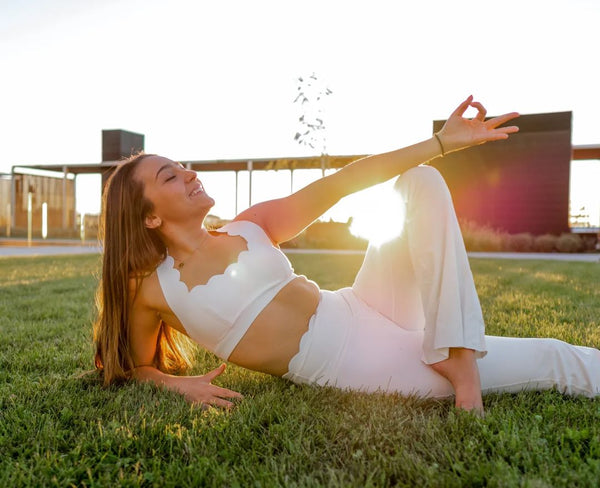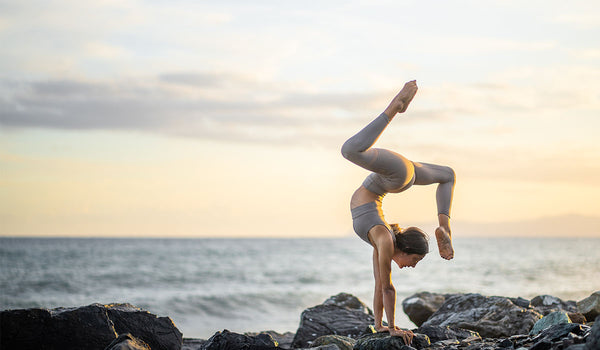
ぴったりフィットするスポーツブラの選び方は?

様々な研究や調査によると、 女性の80%以上が間違ったサイズのブラジャーを着用しているスポーツブラを買う時、魅力的な柄や派手な色に目が留まってしまう方は、もしかしたらあなたもその一人かもしれません。間違ったサイズのブラを購入している可能性が高く、胸の痛みや垂れにつながる可能性があります。でも、そんな心配は無用です。自分にぴったりのサイズを見つける方法を学ぶことができます。
見つける ベストスポットブラ 動きを半分に抑えるには、ブラジャーの構造からフィット感まで、自分に合ったブラジャーを選ぶために必要な情報をすべてご紹介します。 ウィスキー あなたにぴったりのジム アスレジャーを見つけるお手伝いをします。
良い スポーツブラ?
クーパー靭帯は、乳房を支える薄く繊細な結合組織の束です。大胸筋と小胸筋は乳房の裏側に位置しており、乳房を全く支えていません。
簡単に言えば、乳房は事実上、何の支えもありません。そのため、研究によると、運動中、乳房は縦、横、そして左右に動きます。乳房はあらゆる方向・平面で動く際に、8の字を描くように動きます。
研究によると、支えのない乳房は歩くと約4cm、走ると約15cm動きます。乳房の動きの典型的な測定値は、乳房のサイズが大きくなるにつれてさらに大きくなります。これは、女性が走る、スキップする、ジャンプするなどの高負荷の運動中に乳房の動きが大きくなり、不快感や痛みを感じる理由を説明しています。
不快感や痛みに加え、運動は乳房を支えるクーパー靭帯や乳房組織の周囲の皮膚に不可逆的な伸張を引き起こす可能性があります。サポート力のあるブラジャーを着用せずに運動すると、乳房の垂れにつながる可能性があります。
サイズの合わないブラジャーは役に立ちません。しかし、良いことに、サポート力があり、正しくフィットするブラジャーは スポーツブラ から ウィスキーアクティブ 状況を変える可能性があります。乳房の動きを抑え、乳房の痛みや垂れのリスクを軽減するのに役立ちます。
スポーツブラの種類
買い物に行く前に、スポーツブラの種類を知っておく必要があります。
圧縮スポーツブラ 胸を胸壁に押し付け、動きを抑制します。ホックのないプルオンタイプのブラジャーで、胸を寄せ付けないカップもありません。コンプレッションブラはサイズ調整ができず、レギュラーサイズ(Sサイズ)からラージサイズ(Lサイズ)まで展開されていますが、カップサイズは指定されていません。
カプセル化スポーツブラ 左右の胸を囲む独立したカップが、サポート力とリフトアップ効果をもたらします。カップは、ワイヤー、モールディング、シームなどの工夫によって、胸をしっかりと支えます。これらのブラジャーは、背面に伝統的なホックと留め具が付いており、様々なカップサイズやアンダーバストサイズが揃っています。
コンビネーションスポーツブラ 圧縮と包み込みのスポーツブラの利点を組み合わせ、胸のサポートを強化します。この技術では、カップを使用して 個別乳房サポート 乳房を胸壁に押し付けながら。

自分にぴったりのスポーツブラの選び方
適切なタイプがわかったと思いますので、どのように選ぶかを見てみましょう。 最高のスポーツブラ。
ブラジャーのサイズを見つける
正しいブラジャーのサイズを見つけることは、ブラジャーを購入する第一歩です。 ぴったりフィット スポーツブラ最近胸のサイズを測っていない場合は、ここに簡単なガイドラインがあります。
まずは、胸の自然な形を変えないパッドなしのブラジャーを着用し、柔らかいメジャーを用意しましょう。裸の状態でブラジャーのサイズを測ることもできます。
胸郭を測定します: 胸郭の真下、胸郭の周りにメジャーを巻き付けます。測定値を最も近いインチに切り上げます。
| 胸郭測定 | バンドサイズ |
| 25~27インチ | 30 |
| 27~29インチ | 32 |
| 29~31インチ | 34 |
| 31~33インチ | 36 |
| 33~35インチ | 38 |
| 35~37インチ | 40 |
| 37~39インチ | 42 |
| 39~41インチ | 44 |
バンドサイズを調べる: 使用 チャートガイド 自分のサイズを把握するため。
カップサイズを調べましょう: カップサイズを測るには2つのステップがあります。まず、バストの一番膨らんだ部分にメジャーを巻き付けます。次に、その2つの測定値を差し引きます。その差がインチ単位でのカップサイズです。
| 胸郭とバストの測定値の違い | カップサイズ |
| 3インチ | AA |
| 4インチ | あ |
| 5インチ | B |
| 6インチ | C |
| 7インチ | D |
| 8インチ | DD |
| 9インチ | E |
| 10インチ | F |
適切なサポートレベルを選択する
スポーツブラには、低、中、高衝撃など、さまざまなサポートレベルがあります。
低~中衝撃スポーツブラ: これらのスポーツブラは、筋力トレーニング、ヨガ、ウォーキングなどの衝撃の大きいアクティビティに最適です。また、サイクリング、スキー、ダンスなど、中程度の衝撃のかかるアクティビティにも適しています。カップレスデザインのため、胸を圧迫する傾向があります。
高衝撃スポーツブラ: その名の通り、ハイインパクトスポーツブラは、ランニング、マウンテンバイク、エアロビクスといった高負荷の運動に最適です。通常のブラジャーと同様に、カップ構造が明確に設計されており、バストを包み込み、圧迫することで最大限のサポート力を発揮します。
ブラジャーが自分にぴったり合うかどうかを判断する
最高のスポーツブラを見つけるための理論的な部分を理解したので、次は実用的な部分に移りましょう。
カップ
理想的には、スポーツブラのカップは両方の胸を覆い、胸が上向きや横向きに動くのを防ぐ必要があります。
- 小さすぎるカップが肉に食い込んだり、乳房がはみ出したりすること
- 大きすぎる: 隙間やカップ生地のたるみ
ストラップ
ストラップは快適でしっかりと固定され、それでいてしっかりとフィットするのが理想的です。肩とストラップの距離を確認し、自分に合っているか確認してください。指2本分以上は入らないようにしてください。
- きつすぎる: ストラップが肩に食い込む
- 緩すぎる: 肩からストラップが落ちる
バンド
スポーツブラのバンドは胸郭にぴったりとフィットするはずです。理想的には、バンドと背中の間に指2本が余裕で入るくらいが理想です。
- 小さすぎる: 背中の膨らみ
- 大きすぎる腕を上げるとバンドが上がったり開いたりする
テスト!
スポーツブラを着用した状態で、実際に動きを真似て試してみましょう。最適なスポーツブラは、胸をしっかりと支え、揺れを抑え、快適に着用できます。
追加のヒント
以下に、見つけるのに役立つ追加のヒントをいくつか示します。 適切なスポーツブラのフィット感。
- ギャップに注意: 理想的には、ワイヤーが胸の下、胸郭に沿って平らにフィットするようにしてください。食い込んだり締め付けたりしてはいけません。
- きついブラジャーは避ける: スポーツブラは胸にぴったりフィットしますが、締め付け感は感じられません。
- 別のオプションに移動する場合 その 生地がシワシワ: ブラジャーにシワがある場合は悪い兆候であることを覚えておいてください。各カップは見た目も感触も滑らかであるべきです。
結論
ぴったりフィットしてしっかり支えてくれるブラジャーは必需品です。絶対に譲れません!AカップでもDカップでも、胸は重力に抗うために最適なサポートが必要です。運動中は、胸にかかる負担が非常に大きいですから。運動中、胸は蝶々模様のように上下左右に揺れ動きます。
最高の スポーツブラ 運動中の胸の動きを軽減し、胸を安全かつ快適に保ちます。 Wイスキ スタイリッシュで快適、そして完璧なフィット感のアスレジャーウェアをお探しなら、ぜひ当店へ。優れたサポート力でバストの揺れを抑えるスポーツブラを豊富に取り揃えています。













